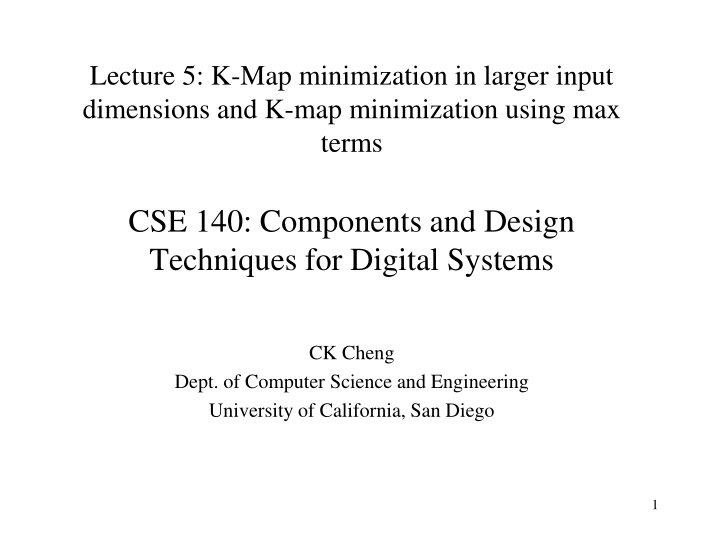
K-Map Minimization Techniques for Digital Systems
Learn about K-Map minimization in larger input dimensions and using max terms in CSE 140 course at the University of California, San Diego. Understand the concepts of sum of products, product of sums, essential prime implicants, and more through practical examples and illustrations.
Download Presentation

Please find below an Image/Link to download the presentation.
The content on the website is provided AS IS for your information and personal use only. It may not be sold, licensed, or shared on other websites without obtaining consent from the author. If you encounter any issues during the download, it is possible that the publisher has removed the file from their server.
You are allowed to download the files provided on this website for personal or commercial use, subject to the condition that they are used lawfully. All files are the property of their respective owners.
The content on the website is provided AS IS for your information and personal use only. It may not be sold, licensed, or shared on other websites without obtaining consent from the author.
E N D
Presentation Transcript
Lecture 5: K-Map minimization in larger input dimensions and K-map minimization using max terms CSE 140: Components and Design Techniques for Digital Systems CK Cheng Dept. of Computer Science and Engineering University of California, San Diego 1
Part I. Combinational Logic 1. Specification 2. Implementation K-map: Sum of products Product of sums 2
Definitions: Sum of Products and Product of Sums Expressions Sum of Products Expression Implicant: A product term that has non-empty intersection with on- setF and does not intersect with off-set R . Prime Implicant: An implicant that is not a proper subset of any other implicant. Essential Prime Implicant: A prime implicant that has an element in on-set F but this element is not covered by any other prime implicants. Product of Sums Expression Implicate: A sum term that has non-empty intersection with off- set R and does not intersect with on-set F. Prime Implicate: An implicate that is not a proper subset of any other implicate. Essential Prime Implicate: A prime implicate that has an element in off-set R but this element is not covered by any other prime implicates. 3
K-Map to Minimized Product of Sums Sometimes it is easier to reduce the K-map by considering the offset F1=a b c d+abc d+a b cd +abcd F2=(a+b )(a +b)(c +d )(c+d) ab 11 0 1 0 1 00 0 1 0 1 01 10 0 0 0 0 cd 0 0 0 0 iClicker: Which function is simpler for a two level logic implementation? A. F1 B. F2 C. Two are the same 00 01 11 10 4
K-Map to Minimized Product of Sums Sometimes it is easier to reduce the K-map by considering the offset F1=a b c d+abc d+a b cd +abcd F2=(a+b )(a +b)(c +d )(c+d) ab 11 0 1 0 1 00 0 1 0 1 01 10 0 0 0 0 cd 0 0 0 0 00 01 11 10 5
Another min product of sums example Given R(a,b,c,d) = m (3, 11, 12, 13, 14) D(a,b,c,d)= m (4, 8, 10) ab cd 00 K-map 00 01 11 10 0 4 12 8 1 5 13 9 01 3 7 15 11 11 2 6 14 10 10 6
Another min product of sums example Given R(a,b,c,d) = m (3, 11, 12, 13, 14) D(a,b,c,d)= m (4, 8, 10) ab 00 01 11 10 cd 0 4 12 8 00 1 X 0 X 1 5 13 9 01 1 1 0 1 d 3 7 15 11 11 0 1 1 0 2 6 14 10 10 1 1 0 X a 7
Prime Implicates: M(0,8), M(11,15), M(12,13,14,15), M(6,14) PI Q: Which of the following is a not an essential prime implicate? A. M(0,8) B. M(11,15) C. M(12,13,14,15) D. M(6,14) 01 ab 00 01 11 10 cd 0 4 12 8 00 0 1 0 X 1 5 13 9 1 1 0 1 d 3 7 15 11 11 1 1 0 0 2 6 14 10 10 1 X 0 1 8 a
Five variable K-map a=0 a=1 11 bc 11 00 01 10 00 01 10 de c c 0 4 12 8 16 20 28 24 00 1 5 13 9 17 21 29 25 01 11 10 e e 3 7 15 11 19 23 31 27 d d 2 6 14 10 18 22 30 26 b b a Neighbors of m5 are: minterms 1, 4, 7, 13, and 21 Neighbors of m10 are: minterms 2, 8, 11, 14, and 26 9
Reading a Five variable K-map: An example a=0 a=1 11 bc 11 00 01 10 00 01 10 de c c 0 4 12 8 1 1 1 1 1 16 20 28 24 1 00 1 1 5 13 9 17 21 29 25 01 11 10 e e 3 7 15 11 19 23 31 27 1 1 1 1 1 1 1 1 d d 2 6 14 10 1 1 1 18 22 30 26 b b a 10
Six variable K-map d d 0 4 12 8 16 20 28 24 1 5 13 9 17 21 29 25 f f 3 7 15 11 19 23 31 27 e e 2 6 14 10 18 22 30 26 c c d d 32 36 44 40 48 52 60 56 33 37 45 41 49 53 61 57 a f f 35 39 47 43 51 55 63 59 e e 34 38 46 42 50 54 62 58 c c b 11
